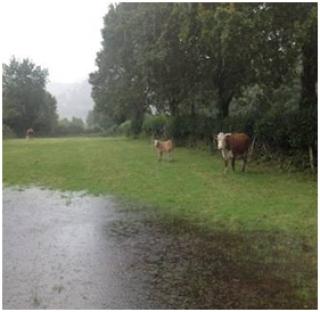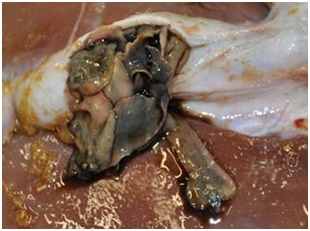Liver Fluke in Sheep and Cattle - A Major Animal Health Concern Following One of the Wettest UK Summers on Record
Published on 24 January 2013 in Sustainability and Communities , Climate, water and energy , Food, health and wellbeing

Introduction
The summer of 2012 has been one of the wettest summers on record and it is held responsible for the extraordinary levels of disease and death in sheep due to liver fluke.
This past autumn and winter, the occurrence of death due to liver fluke had increased 10-fold compared to 2011 values, based on submissions to veterinary diagnostic centres.
Liver fluke is a highly pathogenic flatworm parasite of sheep and cattle and the potential losses it causes can be very high.
Liver fluke in sheep, and increasingly in cattle, is a significant health and welfare issue, but it is also of considerable economic importance to the UK livestock industry, due to direct production losses, poor reproductive performance and livers condemned at slaughter.
Poor liveweight gain in lambs associated with chronic liver fluke disease has been estimated to cost approximately £25-30 per infected sheep (EBLEX 2011) and in beef cattle has been shown to depress liveweight gain with animals taking longer to reach market weight, at a cost of £50 per beast (Mackintosh Donald, 2012).
In dairy cattle, fluke infection can reduce calving rates by up to 30% and milk yield by as much as 0.5kg per day. Furthermore, as a result of infection, the livers and bile ducts become highly fibrosed and calcified resulting in high cattle liver condemnation rates at the abattoir, currently ~25% in the UK.
Key Points
- Liver fluke causes animal disease, death and waste at slaughter and increases the carbon footprint of lamb, beef and milk production. The occurrence of liver fluke disease has been linked to climate change and land use issues, such as Environmentally Sensitive Area schemes.
- The incidence of liver fluke has increased steadily over the past 10-15 years due to the wet, mild summers and mild winters that the UK has generally experienced. Not surprisingly, therefore, 2012 was widely predicted to be a high risk year for fluke, and so it has proved! We have seen fluke outbreaks in previously fluke-free areas and unusually severe fluke problems in traditionally ‘fluky’ areas. In addition, flooding events have served to compound the problem by disseminating infected snails and parasites.
- The impact of weather, climate and land use on the occurence of liver fluke is due to the fact that the fluke has a complicated life cycle involving a tiny mud snail intermediate host, which is typically found on low-lying, poorly drained farmland. The presence of the appropriate species of mud snail and suitable snail habitat is absolutely central to the maintenance of the fluke’s life cycle on a farm – no snails, no fluke!
- Control of fluke has historically involved the strategic application of flukicidal drugs combined, where practical, with measures to reduce the snail populations and/or management aimed at avoiding grazing infected areas. However, this approach is not thought to be sustainable in the face of increasing reports of flukicide resistance.
- The emergence of parasite populations that are resistant to products used for their control is an inevitable consequence of repeated treatment and selection pressure. The extent of flukicide resistance in the UK is currently unknown, although probably low at this time. However, the widespread resistance to the broad-spectrum wormers used to treat gastrointestinal nematodes in livestock, especially sheep, should act as a warning as to what can happen if previously effective drugs are misused or over-used.
- Treatment regimes are complex due to several factors including the fact that treatment intervals will depend on the spectrum of activity of the flukicide and local conditions, therefore, farmers are recommended to consult their veterinary surgeon for advice on the most appropriate treatment strategy for suspected outbreaks of liver fluke.
- Diagnosis of fluke in dead animals is easy, but at that point it is too late. Diagnosis of fluke in live animals is not straightforward. Efforts to develop improved diagnostic tests are underway but do not provide an immediate solution. There is also no vaccine avaialble against liver fluke.
- In recent years, we have seen a steady increase in diagnoses of another fluke parasite, rumen fluke, which has been reported to cause death and disease in young stock, both sheep and cattle. Although the rumen fluke parasite may be becoming increasingly common, clinical rumen fluke disease is still very rare. Liver fluke remains the most important fluke infection in sheep and cattle at this time.
Research Undertaken
 Research at Moredun which has recently been implemented is aimed at:
Research at Moredun which has recently been implemented is aimed at:
- Improving diagnosis of active fluke infection in the host animal through an evaluation of existing blood and faecal fluke tests
- Evaluating alternative diagnostic approaches based on molecular techniques
- Determining the efficacy of flukicidal treatment as a measure of emerging resistance
- Monitoring fluke infection levels on farm as a predictor of disease risk, by measuring intermediate host snail abundance and fluke infection levels over the grazing season
- Determining the species identity of rumen fluke in the UK and its potential implications for the epidemiology and pathogenicity of rumen fluke infection
- Determining the impact of co-infection with liver fluke and rumen fluke on the accuracy of disease diagnosis
- Identifying novel vaccine targets on the surface of the fluke gut – this approach has been particularly successful against other blood-feeding parasites such as Haemonchus contortus
Policy Implications
The increasing world population and expected rising demand for livestock products has focused attention on the need for food security, which can be seriously affected by disease issues. Given the importance of agriculture to Scotland’s economy as a whole, and the need to maintain rural communities, effective control of endemic parasitic diseases, such as liver fluke, is an important issue.
The reliance of farmers and practitioners on a blueprint for parasite control in such a changing environment is unsustainable. This factor combined with the high and increasing economic impact of liver fluke, and concerns for animal health and welfare, highlights the urgent requirement for increasing research in areas such as the development of early and sensitive diagnostic tests; monitoring emerging flukicide resistance; the identification of novel vaccine targets and epidemiological studies to effectively monitor the spread of the parasite and its snail host.
At present all available data have come from passive surveillance through diagnosable submissions to veterinary investigation (VI) centres. Active surveillance is required to monitor parasite populations on Scottish farms and, in future, accurate regional parasite forecasting would be beneficial in order to remain vigilant in a changing environment.
Authors
Philip Skuce philip.skuce@moredun.ac.uk
Ruth Zadoks ruth.zadoks@moredun.ac.uk
Topics
Sustainability and Communities , Climate, water and energy , Food, health and wellbeing







